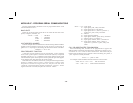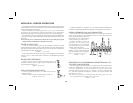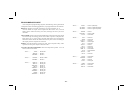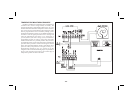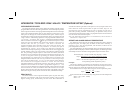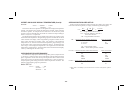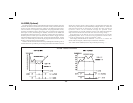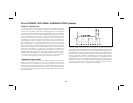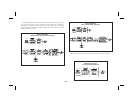
INTEGRATOR / TOTALIZER / PEAK / VALLEY / TEMPERATURE OFFSET (Optional)
INTEGRATOR/TOTALIZER
Theintegrator/totalizeroptionsimplyaddsinputreadingstogetherusinga
programmable time base and scaling coefficient. The decimal point position
oftheintegrator/totalizercanbeprogrammedindependentofthescaledinput
signal. The integrator/totalizer may be reset through a remote input, by the
front panel or through the serial communications option. Alarms may be
programmed to trigger from integrator/totalizer values; for example to total
“degreeminutes”forbatching operations.Theprogrammabletimebases are
“persecond”,“perminute”and“perhour”,meaningtheintegrator/totalizer
willaccumulate at afixed rateof
2
1
2
timesper second andbe equalto a fixed
input level over the selected time period. For example, if the input is a
constant 100° and the “per minute” time base is selected, the
integrator/totalizer will accumulate at the rate of 100° per minute. The
totalizer is updated at this rate every 400 msec. As a result, the input is
accumulated in “batches” of 6.6 counts every 400 msec. Therefore, the
totalizerstartandstopsequencing,aswellasalarmvaluessetfortriggeringat
specific totalizer values, are only accurate to the 400 msec totalizer update
rate. The preceding example requires a scale factor of 1.000 to yield exact
time bases, but any scale factorcan beused to span between the ranges. (See
section on integrator/totalizer programming for detailed information.) A
programmable low temperature level disable feature completes the
integrator/totalizer features (this will stop totalization when the input drops
below this programmed value,“low cut”).At loss of power to the indicator,
the contents of the integrator/totalizer is saved. This will allow
integrating/totalizing of interrupted processes. The total can accumulate to
999,999. If the low-end cut-out value is programmed negative (ex. -100,
referenceProgramModule#5),andtheinputdisplayvalueisbetweenzeroand
the low-end cut-out value, the totalizer value will decrement. If the input
displayvaluegoesabovezerothetotalwillincrement.Ifthedisplayvaluegoes
below(morenegativethan),thelow-endcut-outvalue,totalizationwillstop.
PEAK/VALLEY
The other features of the integrator/totalizer option are peak and valley
detection. The indicator will record the lowest reading (valley) and the
highest reading (peak), automatically, for later recall. This information is
valuablein monitoringthe limitsof the processover anylength oftime since
these values are stored at power-down to span over shifts, days, etc. An
external input can be programmed to reset or engage the unit into a
peak/valley reading indicator. Additionally, the peak and valley can be
viewedandresetfromthefrontpanel,ifsoprogrammed,andviewedandreset
from the serial communication option.
Note: The peak/valley measurement is not instantaneous, and is based on a
nominal 2 sec. response time.
OFFSET AND SLOPE DISPLAY TEMPERATURE
If a difference exists between the displayed temperature and a reference
temperature point, the display may be offset for this effect. Similarly, a
correcting “slope” may be programmed, with the offset, to allow for two
point temperature correction.
Formostapplications,theslopeandoffsetvaluesarenotchanged.Butifitis
requiredtoscalethedisplaytomatchacalibratedprobe,thefollowingformula
and example show the calculation of appropriate slope and offset values.
Desired Display = (slope x actual temp. display) + offset
slope =
difference of two desired temperature points
difference of two actual temperature points
offset = one desired temperature point - (slope x one
corresponding actual temperature point)
Example:
The meter is displaying 52 degrees and 146 degrees (actual temperature)
when the calibrated temperature reference shows that 50 degrees and 150
degrees respectively should be displayed (desired temperature).
First determine the new slope value using the sets of temperature points.
slope =
150-50
=
100
= 1.0638
146 - 52 94
Next,determinethenewoffsetvaluebyusingeitheroneofthetemperature
pairs.
offset = 150 - (146 x 1.0638)
offset = 5.3
-23-




